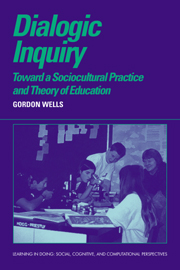Book contents
- Frontmatter
- Contents
- Conventions of Transcription
- Introduction
- Part I Establishing the Theoretical Framework
- Part II Discourse, Learning, and Teaching
- Part III Learning and Teaching in the zpd
- 9 On Learning With and From Our Students
- 10 The Zone of Proximal Development and Its Implications for Learning and Teaching
- Appendix I A Social Constructivist Model of Learning and Teaching
- Appendix II Categories for the Analysis of Discourse
- References
- Index of Authors
- Index of Subjects
- Title in the series
9 - On Learning With and From Our Students
Published online by Cambridge University Press: 09 November 2009
- Frontmatter
- Contents
- Conventions of Transcription
- Introduction
- Part I Establishing the Theoretical Framework
- Part II Discourse, Learning, and Teaching
- Part III Learning and Teaching in the zpd
- 9 On Learning With and From Our Students
- 10 The Zone of Proximal Development and Its Implications for Learning and Teaching
- Appendix I A Social Constructivist Model of Learning and Teaching
- Appendix II Categories for the Analysis of Discourse
- References
- Index of Authors
- Index of Subjects
- Title in the series
Summary
The Authors
Barbara Galbraith teaches a Grade 2 class and Mary Ann Van Tassell a combined class of Grade 1 and Grade 2 children. Through creative time tabling, we have arranged, each Wednesday afternoon, to work together on science with a group of some twenty Grade 2 children drawn from both our classrooms. Although we have been team teaching together for several years, and have progressively modified our teaching strategies in order to allow opportunities for the children to engage in hands-on investigations, we were still dissatisfied, when we reviewed our program at the beginning of this year, with the relationship between the questions that the children generated in the course of these investigations and our own teacherly agenda. Specifically, we noticed that, although we encouraged and noted their questions, we did not give them a central place in planning subsequent activities; in a sense, their questions were more an outcome of the topics we tackled rather than a point of departure for their organization. Our own question, then, was how could we arrange for the children's questions to play a more generative role in the planning of the science curriculum?
This question was also of interest to Gordon Wells, a researcher and teacher educator at the university, who, with Mary Ann, is a member of an action research project which is exploring ways to give a greater emphasis to inquiry in the curriculum.
- Type
- Chapter
- Information
- Dialogic InquiryTowards a Socio-cultural Practice and Theory of Education, pp. 293 - 312Publisher: Cambridge University PressPrint publication year: 1999



